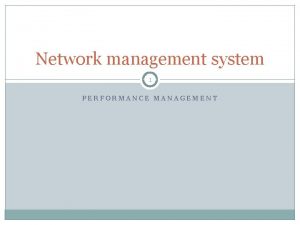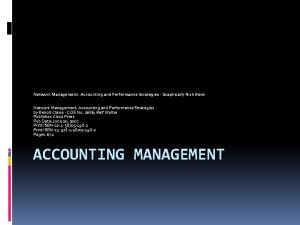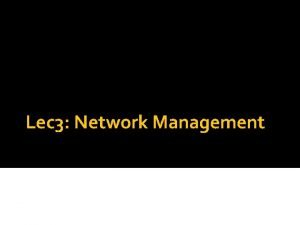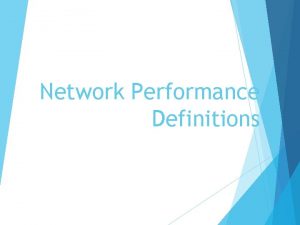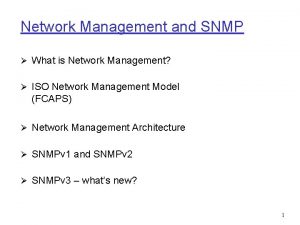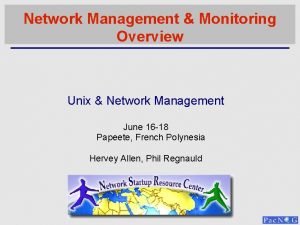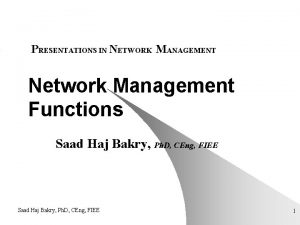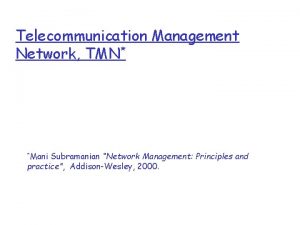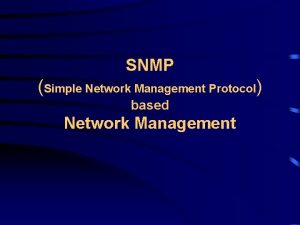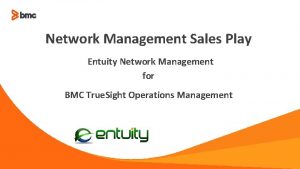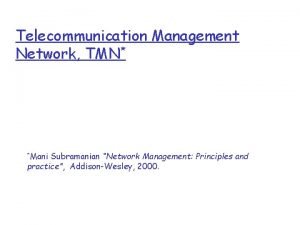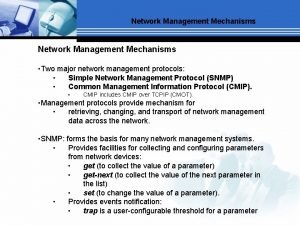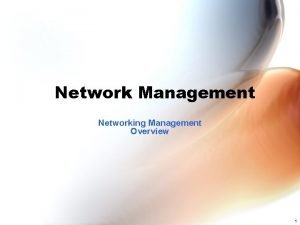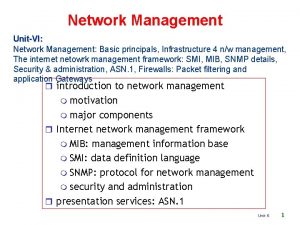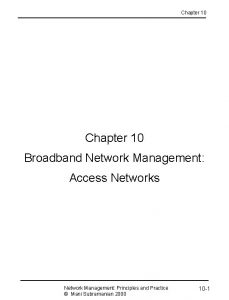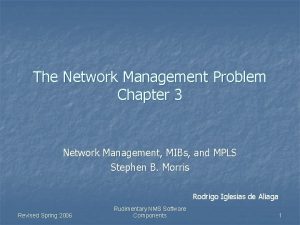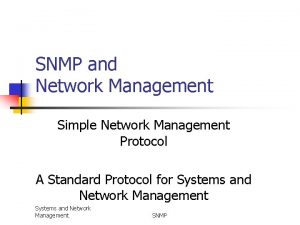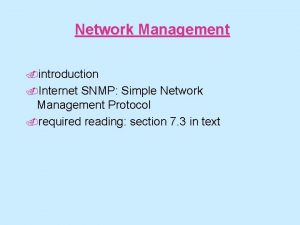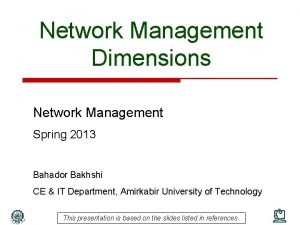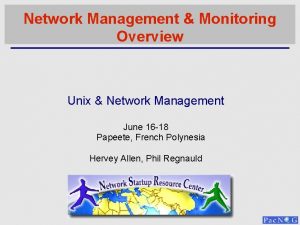Network Management What is network management In the























































- Slides: 55

Network Management

What is network management? • In the early days, network was small and local Network manager’s job includes • Installation: attach PCs, printers, etc. to LAN • Configuration: NICs, protocol stack, user app’s shared printers, etc. • Testing: Ping was sufficient to “manage” network • More devices: bridge, router • Above only deals with configuration and ongoing maintenance issues, what about • How to optimize performance? • How to handle failures and network changes? • How to extend network capacity? • How to account for network usages? • How to solve network security issues?

What is network management? In the past, the network manager might take all the responsibilities, Today the task has divided into specialties: • • • Server admin System admin Network admin Security specialist Different certifications for these are Cisco, Novell, Microsoft, Sun, (ISC)2, etc. • Today, networks are larger and more complicated, so more demands on network manager • How to monitor and control the network effectively and timely? • Management tools are needed • Network-based management tools: use the network to manage the network (remotely) • To Control • Simple Network Management Protocol (SNMP) • Management Information Base (MIB) • Network Management System (NMS) • To Monitor • Remote Monitor (RMON 1)

What is network management? Definition by Saydam (in Journal of Networks and System Management, published in Dec. 1996): Network management includes the deployment, integration and coordination of the hardware, software, and human elements to monitor, test, poll, configure, analyze, evaluate, and control the network and element resources to meet the real-time, operational performance, and Quality of Service requirements at a reasonable cost. In brief: Network management is mostly a combination of local and remote configuration and management with software. Remote network management is accomplished when one computer is used to monitor, access, and control the configuration of other devices on the network.

Network Management Vocabulary agent managing entity data managed device agent network management protocol data managed device agent data managed devices contain managed objects whose data is gathered into a Management Information Base (MIB)

Network Management Vocabulary Managed Device • Devices to be monitored/controlled, e. g. , router, switch, hub, bridge, workstation. • A managed device may have several managed objects to be managed • A software (agent) is installed to provide access to information/parameters (data) about the device, which is called Management Information Base (MIB) Managing Entity • Used by the manager/Admin to do network management • PC, notebook, terminal, etc. , installed with a software called Network Management System (NMS) • NMS displays/analyzes data from management agents

Network Management Vocabulary • Network Management Protocol • Runs between the managing entity and the managed devices • The managing entity can query the status of the managed devices and take actions at the devices via its agents • Agents can use the protocol to inform the managing entity of exceptional events • E. g. , SNMP: Simple Network Management Protocol • Managing agents located at managed devices are periodically queried by the managing entity through a network management protocol.

Network Management System A Network Management System (NMS) is used to design, organize, analyze and administer computer and telecommunication networks, in order to maintain a desired level of service at all times.

ISO Network Management Categories 1. Performance Management 2. Fault Management 3. Configuration Management 4. Security Management 5. Accounting Management


Performance Management Concerned with • Response time • Utilization • Error rates, etc. Must collect and analyze data • Number and type of packets • Might also rely on simulations

Performance Management Sub-Categories Collecting Baseline Utilization Data • • Measuring link utilization using a probe Counting packets received/transmitted by a specific device Measuring device processor usage Monitoring device queue lengths Monitoring device memory utilization Measuring total response times Collecting a History of Utilization Data • Measuring utilization and response times at different times of the day Measuring utilization and response times on different days over an extended period Capacity Planning • Manually graphing or using a network management tool to graph utilization as a function of time to detect trends Preparing trend reports to document projected need for and the cost of network expansion. • Setting Notification Thresholds • • Building Databases • Having a network management tool poll devices for values of critical parameters and graphing these values as a function of time Setting polling intervals Setting alarms/alerts on those parameters when the threshold is reached or a percentage of it is reached Initiating an action when the threshold is reached such a sending a message to the network manager. Having the network management tool create a database of records containing device name, parameter, threshold and time for off-line analysis. Using the database to extract time dependence of utilization Using the time dependence of parameters to decide when network upgrades will be necessary to maintain performance Running Network Simulations • Using a simulation tool to develop a model of the network Using the model’s parameters and utilization data to optimize network performance Latency • Query/Response time interval

Fault Management Preventions, detection and isolation of abnormal behavior (The process of locating problems, or faults, on the data) • May be caused by malfunction, cable issue, the janitor, etc. Traffic, trends, connectivity, etc. • Detect the fault • Determine exactly where the fault is • Isolate the rest of the network from the failure so that it can the impact • Reconfigure or modify the network in such a way as to minimize – Repair or replace the failed components • Tests: connectivity, data integrity, response-time, . .

Fault Management Sub-categories Prioritization • • Prioritize faults in the order in which they should be addressed Use in-band management packets to learn about important faults Identify which fault events should cause messages to be sent to the manager Identify which devices should be polled and at what intervals Identify which device parameter values should be collected and how often Prioritize which messages should be stored in the manager’s database Timeliness Required • Management Station is passive and only receives event notifications Management Station is active and polls for device variable values at required intervals Application periodically requests a service from a service provider Physical Connectivity Testing Using a cable tester to check that links are not broken Software Connectivity Testing Using an application that makes a request of another device that requires a response. The most often application for this is Ping. Exe. It calls the Internet Control Message Protocol ( ICMP) which sends periodic Echo Request messages to a selected device on a TCP/IP network Application on one device makes a request of an application on another device Device Configuration • Devices are configured conservatively to minimize chances of dropped packets. SNMP Polls Devices are periodically polled to collect network statistics Fault Reports Generated • • Thresholds configured and alarms generated Text media used for report Audio media used for report A color graphical display used to show down devices Human manager is notified by pager Traffic Monitored • • • Remote Monitors used Protocol analyzers used Traps sent to Network Management Station Device statistics monitored Trends Graphical trends generated to identify potential faults

Configuration Management • The configuration of certain network devices controls the behaviour of the data network • Configuration management is the process of finding and setting up (configuring) these critical devices • It Involves following steps: a) Installation of new hardware/software b) Tracking changes in control configuration c) Who, what and why? - network topology d) Revert/undo changes e) Change management f) Configuration audit g) Does it do what was intended

Configuration Management Sub-categories Configuration (Local) • Choice of medium access protocol Choice of correct cabling and connectors Choice of cabling layout Determining the number of physical interfaces on devices Setting device interface parameter values Interrupts I/O Addresses DMA numbers Network layer addresses (e. g. IP, Net. Ware, etc) Configuration of multiport devices (e. g. hubs, switches and routers) Use of the Windows Registry Comparing current versus stored configurations Checking software environments SNMP service Configuration (Remote) • • From the network management station Disabling device ports Redirecting port forwarding Disabling devices Comparing current versus stored configurations Configuring routing tables Configuring security parameters such as community strings and user names Configuring addresses of management stations to which traps should be sent Verifying integrity of changes

Configuration Management Sub-categories Configuration (Automated) • • Using the Dynamic Host Configuration Protocol (DHCP) to configure IP addresses Using Plug and Play enabled NICs for automatic selection of interrupts and I/O addresses Domain Name Services (DNS) addresses Trap messages from agents Inventory (Manual) • • • Maintaining records of cable runs and the types of cables used Maintaining device configuration records Creating network database containing for each device: Device types Software environment for each device operating systems utilities drivers applications versions configuration files (. ncf, . ini, . sys) vendor contact information IP address Subnet address Inventory (Automated) • Auto-discovery of devices on the network using an NMS Auto-determination of device configurations using an NMS Creation of a network database Auto-mapping of current devices to produce a network topological map Accessing device statistics using an NMS and the Desktop Management Protocol

Security Management • Control access to network/resources • Authentication: who goes there? • Authorization: are you allowed to do that? • Firewalls • Intrusion detection systems (IDS) • Notification of (attempted) breaches, etc. • Critical to always authenticate participants • SNMPv 1 has very little security • SNMPv 3 has lots of security built in

Security Management Sub-categories Applying Basic Techniques • • Identifying hosts that store sensitive information Management of passwords Assigning user rights and permissions Recording failed logins Setting remote access barrier codes Employing virus scanning Limiting views of the Enterprise network Tracking time and origin of remote accesses to servers Identifying Access Methods Used • • • Electronic Mail File Transfer Web Browsing Directory Service Remote Login Remote Procedure Call Remote Execution Network Monitors Network Management System Using Access Control Methods • • Encryption Packet filtering at routers Packet filtering at firewalls Source host authentication Source user authentication Maintenance • • Audits of the activity at secure access points Executing security attack programs (Network Intrusion Detection) Detecting and documenting breaches Accessing Public Data Networks • • No restrictions - hosts are responsible for securing all access points Limited access - only some hosts can interface with the Public Data Network using a proxy server Using an Automated Security Manager • • Queries the configuration database to identify all access points for each device. Reads event logs and notes security-related events. Security Manager shows a security event on the network map. Reports of invalid access point attempts are generated daily for analysis

Accounting Management • Involves tracking individual’s utilization and grouping of network resources to ensure that users have sufficient resources • Involves granting or removing permission for access to the network • Identifying consumers and suppliers of network resources - users and groups • Mapping network resources consumption to customer identity • Billing E. g. , monitoring the use of a server by users in a specific department and charging the department accordingly

Accounting Management Sub-categories Gather Network Device Utilization Data • Measure usage of resources by cost center Set quotas to enable fair use of resources Site metering to track adherence to software licensing Bill Users of Network Resources • • Set charges based on usage. Measure one of the following Number of transactions Number of packets Number of bytes Set charges on direction of information flow Use and Accounting Management Tools • Query usage database to measure statistics versus quotas Define network billing domains Implement automatic billing based on usage by users in the domain Enable billing predictions Enable user selection of billing domains on the network map Reporting • Create historical billings trends Automatic distribution of billing to Cost Centers Project future billings by cost center

Management Tools Company Product URL Comments Apptitude (Hi. Fn) Meterware/ Analyzer http: //www. hifn. com NMS used in this book. Is a complete SNMPv 1 tool. It is only available with the book. Apptitude was a leader in SNMP management software and hardware for many years. Hi. Fn develops integrated circuits for encryption. SNMP Research Internation al http: //www. snmp. com/index. html Enter. Pol is a NMS. CIAgent is an agent. CIAgent is a free download. SNMPv 3 Wizard is an agent configuration tool. The company has many other products. The company has been a leader in the SNMP field Castlerock Snmp. C http: //www. castlerock. com/ The Work Group Edition 5. 1 is appropriate for small networks It supports SNMPv 3, as does the Enterprise edition that provides other capabilities. Cost of the Work Group Edition is $995. 00 The company has been a leader in the SNMP field Solar Winds Engineers Edition http: //solarwinds. net/ Provides a number of management tools ranging in price from $145 to $1995. The $1995. 00 package is Webenabled. The Engineers Edition at $995. 00 looks like the most attractive for users of this book in that it contains most of the features of the Hi. Fn Ama; uzer. MG-SOFT Net Inspector Lite http: //www. mg-soft. si/ Net Inspector Lite is $495. 00. It looks like a good choice for readers of this book. MG-SOFT provides many other more comprehensive products and products can be enhanced by proxy front-end modules. There also products that support SNMPv 3 Enter. Pol CIAgent SNMPv 3 Wizard

Management Tools Triticom LANdecoder SNMP Manager http: //www. triticom. com/ LANdecoder SNMP Manager is a simple, easy to use SNMP Manager for Microsoft Windows environment. With it, you can query and control any SNMP-capable device on your network. It can operate standalone or be integrated with Triticom’s LANdecoder 32 V 3. 2. , a network analyzer. The price of LANdecoder SNMP manager is $995. 00 Finisar Shomiti Surveyor http: //www. finisar-systems. com/ Shomiti Systems is now part of Finisar. The Surveyor product is a comprehensive network hardware manager. A free download is available. Acterna Link View Classic 7. 2 http: //www. acterna. com/ A software based network analyzer at a price of $995. 00. Includes a traffic generator. Excellent graphics Also available is Advanced Ethernet Adapter which provides promiscuous capture of packets. Price is then $2700.

Management Tools Company Product URL Comments Network Instruments Observer 8 http: //www. netinst. com/html/observer. ht ml Supports Ethernet, Token Ring, FDDI, Giga. Bit and Windows 98/ME and NT/2000/XP. Includes capture for protocol analysis. Price is $995. 00 Precision Guesswork LANwatch 32 v 6. 0 http: //www. guesswork. com/snmptool. ht ml Described to be an easy-to-use command-line application that allows you to GET a variable, SET a variable, get the NEXT variable, or even get all the variables. Provides programs for receiving ALERTS, as well as a simple monitoring program that allows you to tell if your hosts are SNMP reachable, IP reachable, or not reachable. Allows you to remotely monitor, gather and change networking information from hosts on your network. Enables you to diagnose existing problems on the network, predict where problems are likely to occur, pinpoint faulty routers and interfaces, and, in general, exert control over your network. Cisco Small Network Managemen t LAN Management http: //www. cisco. com/warp/public/cc/pd /wr 2 k/wrsnms/ http: //www. cisco. com/warp/public/cc/pd /wr 2 k/lnmn/ Cisco produces many network management products. These products seem most appropriate for audience of this book.

Management Tools 3 COM Network Supervisor 3. 5 http: //www. 3 com. com/products/en_US/ detail. jsp? tab=features&pathtype= purchase&sku=3 C 15100 C This free package can be downloaded from this site. Other packages are available from this site also. Computer Associates Unicenter Network and Systems Manager 3. 0 http: //www 3. ca. com/Solutions/Sub. Solution. asp? I D=2846 This is the basic network infrastructure management package. There add-on applications available such as a performance application Enterasys Net. Sight Element Mgr. Net. Sight Policy Mgr. http: //www. enterasys. com/products/items/NSEM/ http: //www. enterasys. com/products/items/NETSI GHT-PM/ Element Manager is the basic network management package. Policy Manager incorporates the business model into the management process Sunrise Telecom LAN Explorer http: //www. sunrisetelecom. com/lansoft ware/lanexplorer. shtml A comprehensive NMS, comparable to Analyzer but also containing packet capture and analysis capabilities. $799. 00 per license.

Management Tools Company Product URL Comments HP Toptools http: //www. hp. com/toptools/prodinfo/ov erview. intro. html Toptools is a comprehensive hardware management product. It has many plug-ins for specific hardware. All its features can be integrated into your enterprise management platforms such as hp Open. View Network Node Manager, Microsoft SMS, CA Unicenter TNG, IBM Tivoli Enterprise Management and Tivoli Net. View IBM Tivoli Netview 7. 1 http: //www. tivoli. com/products/index/ne tview/ This comprehensive management product also correlates and manages events for systematic management of faults. Groupe Bull S. A. EVIOIAN (A Bull Company) Openmaster SLM http: //www. bull. com/ Monitoring and control functions encompass systems management, network management, and application management, and it can manage software configurations, hardware assets and batch production. It also works at a higher level, addressing the underlying business needs in a business-oriented way, to provide measurable business value. Compuware Network Vantage http: //www. compuware. com/products/va ntage/networkvantage/ Formerly called Ecoscope, monitors network performance by monitoring protocol and application traffic. Par of a suite called Vantage Net. Scout n. Genius Real Time Monitor http: //www. netscout. com/products/rtm. h tm Real time voice, video and data traffic. Part of the n. Genius Suite. Nortel Optivity 6. 0 Network Managemen t System http: //www. nortelnetworks. com/product s/01/optivity/net_mgmt/index. html Optivity Network Management System is a comprehensive network management solution. Its key features include fault management, performance analysis, reporting, and access level security BGS Patrol Connect SNMP http: //www. bgs. com/products/proddocvi ew. cfm? id=7263 There are many Patrol products by BGS. Connect SNMP seems the most appropriated for this book. BGS products cover all aspects of network management.

Network Management Configuration • Centralized vs distributed • Centralized configuration

Network Management Configuration • Centralized configuration • One management station hosts NMS • Remote monitors/probes on LAN segments • Advantage: NMS has complete view • Disadvantage: single point of failure

Network Management Configuration Distributed Configuration

Network Management Configuration • Distributed configuration • Each LAN has its own management station and a simple NMS • One management station/NMS manages the backbone and coordinates local NMSs • Advantage: robust in case of failure • Disadvantage: complexity, coordination

SIMPLE NETWORK MANAGEMENT PROTOCOL (SNMP) The Simple Network Management Protocol (SNMP) is a framework for managing devices in an internet using the TCP/IP protocol suite. It provides a set of fundamental operations for monitoring and maintaining an internet.

SIMPLE NETWORK MANAGEMENT PROTOCOL (SNMP) CONCEPT SNMP uses the concept of manager and agent. That is, a manager, usually a host, controls and monitors a set of agents, usually routers or servers

Managers and Agents Manager Ø A management station, called a manager, is a host that runs the SNMP client program. A managed station, called an agent, is a router (or a host) that runs the SNMP server program. Management is achieved through simple interaction between a manager and an agent. Ø The agent keeps performance information in a database. The manager has access to the values in the database. Ø The manager can also make the router perform certain actions.

Managers and Agents Agent Ø Agents can also contribute to the management process. The server program running on the agent can check the environment and, if it notices something unusual, it can send a warning message (called a trap) to the manager. Management with SNMP is based on three basic ideas: 1. A manager checks an agent by requesting information that reflects the behavior of the agent. 2. A manager forces an agent to perform a task by resetting values in the agent database. 3. An agent contributes to the management process by warning the manager of an unusual situation.

MANAGEMENT COMPONENTS To do management tasks, SNMP uses two other protocols: Structure of Management Information (SMI) and Management Information Base (MIB). In other words, management on the Internet is done through the cooperation of three protocols: SNMP, SMI, and MIB.

Role of SNMP defines the format of packets exchanged between a manager and an agent. It reads and changes the status (values) of objects (variables) in SNMP packets.

Role of SMI defines the general rules for naming objects, defining object types (including range and length), and showing how to encode objects and values. SMI does not define the number of objects an entity should manage or name the objects to be managed or define the association between the objects and their values.

Role of MIB creates a collection of named objects, their types, and their relationships to each other in an entity to be managed.

Analogy

Analogy Syntax: SMI Before we write a program, the syntax of the language (such as C or Java) must be pre- defined. The language also defines the structure of variables (simple, structured, pointer, and so on) and how the variables must be named. For example, a variable name must be 1 to n characters in length and start with a letter followed by alphanumeric characters. The language also defines the type of data to be used (integer, float, char, etc. ). In programming the rules are defined by the syntax of the language. In network management the rules are defined by SMI.

Analogy Object Declaration and Definition: MIB Most computer languages require that objects be declared and defined in each specific program. Declaration and definition creates objects using predefined type and allocates memory location for them. For example, if a program has two variables (an integer named counter and an array named grades of type char), they must be declared at the beginning of the program: MIB does this task in network management. MIB names each object and defines the type of the objects. Because the type is defined by SMI, SNMP knows the range and size.

Analogy Program Coding: SNMP After declaration in programming, the program needs to write statements to store values in the variables and change them if needed. SNMP does this task in network management. SNMP stores, changes, and interprets the values of objects already declared by MIB according to the rules defined by SMI.

Working

Working A manager station (SNMP client) wants to send a message to an agent station (SNMP server) to find the number of UDP user datagrams received by the agent. MIB is responsible for finding the object that holds the number of UDP user data- grams received. SMI, with the help of another embedded protocol, is responsible for encoding the name of the object. SNMP is responsible for creating a message, called a Get. Request message, and encapsulating the encoded message.

SMI The Structure of Management Information, version 2 (SMIv 2) is a component for net- work management. Its functions are: 1. To name objects. 2. To define the type of data that can be stored in an object. 3. To show to encode data for transmission over the network. SMI is a guideline for SNMP. It emphasizes three attributes to handle an object: name, data type, and encoding method.

MIB The Management Information Base, version 2 (MIB 2) is the second component used in network management. Each agent has its own MIB 2, which is a collection of all the objects that the manager can manage. The objects in MIB 2 are categorized under 10 different groups: system, interface, address translation, ip, icmp, tcp, udp, egp, transmission, and snmp

SNMP uses both SMI and MIB in Internet network management. It is an application program that allows: 1. A 2. A manager to to retrieve store the a value of in an an object defined in in 3. An agent to send an alarm message about an abnormal situation to the manager. an agent.

Comparison of SNMPv 1 and SNMPv 2 Table 8. 1 SNMPv 1 PDU SNMPv 2 PDU Direction Description Get. Request Manager to agent Request value for each listed object Get. Request Manager to agent Request next value for each listed object ------ Get. Bulk. Request Manager to agent Request multiple values Set. Request Manager to agent Set value for each listed object ------ Inform. Request Manager to manager Transmit unsolicited information Get. Response Agent to manager or Manage to manager(SNMPv 2) Respond to manager request Trap SNMPv 2 -Trap Agent to manager Transmit unsolicited information

SNMPv 3 • SNMPv 3 defines a security capability to be used in conjunction with SNMPv 2 preferably or possibly v 1

SNMPv 3 Archttecture Consists of a distributed collection of SNMP entities

SNMP uses both SMI and MIB in Internet network management. It is an application program that allows: 1. A 2. A manager to to retrieve store the a value of in an an object defined in in 3. An agent to send an alarm message about an abnormal situation to the manager. an agent.

SNMP PDU’s SNMPv 3 defines eight types of protocol data units (or PDUs): Get. Request, Get. Next- Request, Get. Bulk. Request, Set. Request, Response, Trap, Inform. Request, and Report

SNMP PDU’s Format

SNMP PDU’s Format

SNMP Messages
 Hát kết hợp bộ gõ cơ thể
Hát kết hợp bộ gõ cơ thể Lp html
Lp html Bổ thể
Bổ thể Tỉ lệ cơ thể trẻ em
Tỉ lệ cơ thể trẻ em Gấu đi như thế nào
Gấu đi như thế nào Tư thế worm breton
Tư thế worm breton Chúa yêu trần thế alleluia
Chúa yêu trần thế alleluia Môn thể thao bắt đầu bằng từ chạy
Môn thể thao bắt đầu bằng từ chạy Thế nào là hệ số cao nhất
Thế nào là hệ số cao nhất Các châu lục và đại dương trên thế giới
Các châu lục và đại dương trên thế giới Cong thức tính động năng
Cong thức tính động năng Trời xanh đây là của chúng ta thể thơ
Trời xanh đây là của chúng ta thể thơ Mật thư tọa độ 5x5
Mật thư tọa độ 5x5 Phép trừ bù
Phép trừ bù Phản ứng thế ankan
Phản ứng thế ankan Các châu lục và đại dương trên thế giới
Các châu lục và đại dương trên thế giới Thơ thất ngôn tứ tuyệt đường luật
Thơ thất ngôn tứ tuyệt đường luật Quá trình desamine hóa có thể tạo ra
Quá trình desamine hóa có thể tạo ra Một số thể thơ truyền thống
Một số thể thơ truyền thống Cái miệng nó xinh thế
Cái miệng nó xinh thế Vẽ hình chiếu vuông góc của vật thể sau
Vẽ hình chiếu vuông góc của vật thể sau Nguyên nhân của sự mỏi cơ sinh 8
Nguyên nhân của sự mỏi cơ sinh 8 đặc điểm cơ thể của người tối cổ
đặc điểm cơ thể của người tối cổ Ví dụ về giọng cùng tên
Ví dụ về giọng cùng tên Vẽ hình chiếu đứng bằng cạnh của vật thể
Vẽ hình chiếu đứng bằng cạnh của vật thể Phối cảnh
Phối cảnh Thẻ vin
Thẻ vin đại từ thay thế
đại từ thay thế điện thế nghỉ
điện thế nghỉ Tư thế ngồi viết
Tư thế ngồi viết Diễn thế sinh thái là
Diễn thế sinh thái là Dot
Dot Số.nguyên tố
Số.nguyên tố Tư thế ngồi viết
Tư thế ngồi viết Lời thề hippocrates
Lời thề hippocrates Thiếu nhi thế giới liên hoan
Thiếu nhi thế giới liên hoan ưu thế lai là gì
ưu thế lai là gì Khi nào hổ mẹ dạy hổ con săn mồi
Khi nào hổ mẹ dạy hổ con săn mồi Khi nào hổ mẹ dạy hổ con săn mồi
Khi nào hổ mẹ dạy hổ con săn mồi Sơ đồ cơ thể người
Sơ đồ cơ thể người Từ ngữ thể hiện lòng nhân hậu
Từ ngữ thể hiện lòng nhân hậu Thế nào là mạng điện lắp đặt kiểu nổi
Thế nào là mạng điện lắp đặt kiểu nổi Network performance management system
Network performance management system Accounting management in network management
Accounting management in network management Introduction to network management
Introduction to network management Accounting management in network management
Accounting management in network management Datagram networks and virtual circuit networks
Datagram networks and virtual circuit networks What is topology in computer
What is topology in computer Features of peer to peer network and client server network
Features of peer to peer network and client server network Ece 526
Ece 526 Network centric computing
Network centric computing Packet switching advantages and disadvantages
Packet switching advantages and disadvantages Scientific management
Scientific management Top management middle management first line management
Top management middle management first line management Top management and middle management
Top management and middle management Snmp model in computer networks
Snmp model in computer networks










































